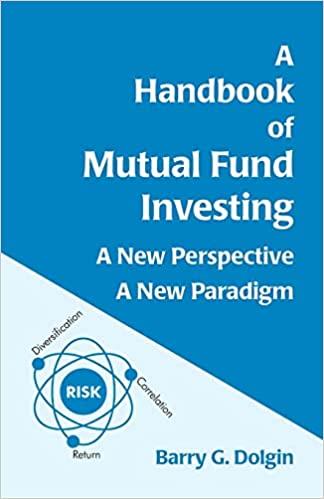Question
1.Modern portfolio theory does not consider diversifiable risk relevant because A) its effects are too small to make a difference in portfolio returns. B) it
1.Modern portfolio theory does not consider diversifiable risk relevant because
A) its effects are too small to make a difference in portfolio returns.
B) it is easy to eliminate.
C) it is impossible to eliminate.
D) its effects are unpredictable.
2.Which one following will lower required rates of return?
A) higher rates of inflation B) lower rates of inflation
C) higher risk premiums D) lower dividend yields
3.Congress considers a bill that would eliminate the mortgage interest deduction for individuals.For the housing industry, this is an example of
A) interest rate risk. B) business risk.
C) tax risk. D) event risk.
4. If there is no relationship between the rates of return of two assets over time, these assets are
A) negatively correlated. B) uncorrelated.
C) perfectly negatively correlated. D) positively correlated.
5.The risk of a portfolio consisting of two uncorrelated assets will be
A) equal to the average of the risk level of the two assets.
B) equal to zero.
C) greater than the risk of the least risky asset but less than the risk level of the more risky
asset.
D) greater than zero but less than the risk of the more risky asset.
6. You have gathered the following information concerning a particular investment and conditions in the market. According to the Capital Asset Pricing Model, the required return for this investment is
A) 13.98%. B) 11.48%. C) 14.85%. D) 8.85%.
7.Which of the following choices is in the correct order from less risk to more risk?
A) certificates of deposit, corporate bonds, mutual funds that invest in stock, common stock
B) certificates of deposit, corporate bonds, common stock, mutual funds that invest in stock
C) corporate bonds, certificates of deposit, mutual funds that invest in stock, common stock
D) certificates of deposit, mutual funds that invest in stock, common stock, corporate bonds
8.The stock of a technology company has an expected return of 15% and a standard deviation of 20% The stock of a pharmaceutical company has an expected return of 13% and a standard deviation of 18%. A portfolio consisting of 50% invested in each stock will have an expected
return of 14 % and a standard deviation
A) greater than the average of 20% and 18%.
B) the answer cannot be determined with the information given.
C) the average of 20% and 18%.
D) less than the average of 20% and 18%.
9.The closest approximation to the real, risk-free rate of interest is
A) The short-term Treasury bill rate minus the inflation rate.
B) The short-term Treasury bill rate plus the inflation rate.
C) The 10 year Treasury bond rate minus the inflation rate.
D) The 10 year Treasury bond rate minus the 1 year Treasury bill rate.
Step by Step Solution
There are 3 Steps involved in it
Step: 1

Get Instant Access to Expert-Tailored Solutions
See step-by-step solutions with expert insights and AI powered tools for academic success
Step: 2

Step: 3

Ace Your Homework with AI
Get the answers you need in no time with our AI-driven, step-by-step assistance
Get Started


